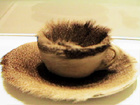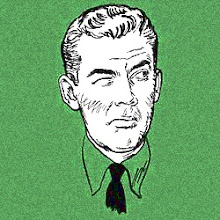 CAConrad and his colleagues at PhillySound worked hard to reproduce the transcript of a 1979 interview Gil Ott conducted with Jackson Mac Low, and it (part? or whole?) has been added to the PhillySound blog.
CAConrad and his colleagues at PhillySound worked hard to reproduce the transcript of a 1979 interview Gil Ott conducted with Jackson Mac Low, and it (part? or whole?) has been added to the PhillySound blog. Mac Low always remembered in detail when his procedure for making his poems developed this way or that. He remembered the process more accurately, one might say, than the poems that got produced by it. Which of course is his point: the process is in a sense the (meaning of the) poem; the medium is (the same as) the message.
Here's Mac Low telling Ott about the first time he used his "nucleic method" (for choosing sourcetexts) in early 1961:
I began using the "Nucleic Method" in 1961, when I wrote a number of poems whose titles begin "From Nuclei..." At that time I also produced a whole pack of cards for improvising performers (NUCLEI FOR SIMONE FORTI), parts of which later became the basis of the series of Dance-Instruction Poems called THE PRONOUNS (3rd edition, Station Hill Press, Barrytown, NY, 1979). (This pack and how I got from it to THE PRONOUNS is described in the prose essay published with the poems.)
At that time in early 1961 I drew several lists of words by means of random digits from the Basic English List. Both the NUCLEI FOR SIMONE and a number of verse poems I wrote at the time were made by using chance means to draw words from these word lists that themselves had been compiled by chance operations. The Basic English list had been compiled in, I think, the 1920's by C.K. Ogden and I.A. Richards. They believed that it included all or most of the most basic words in English and that most other words in English (except for proper names) could be "translated" into combinations of these Basic words. For instance, they translated the whole New Testament into Basic English. They thought that Basic English would be a better universal language than Esperanto, which in the 1920s was the widely used "universal language," albeit an artificial one. Since English was already so widespread, they thought its grammar and basic words would be a better universal language than any artificial one.In making the FROM NUCLEI poems, the NUCLEI FOR SIMONE, and some other 1961 texts, I just used aleatoric means to draw words from their lists, which was in one of my dictionaries. That's when I began working freely between chance-given pivotal points ("nuclei"). Starting with Ogden and Richards' list, I'd let random digits draw a large list, and then often make a smaller list from the larger one, also by means of random digits, for use in any particular poem. As I said, between the chance-given nuclei I wrote pretty freely. I used similar methods in writing THE PRESIDENTS OF THE UNITED STATES OF AMERICA, but in making that series, I used the Phoenician meanings of the successive letters of the alphabet that comprised the presidents' names as my nuclei. For instance "G" is "Gimel" or "camel": thus the first line comes from the first letter of George Washington's name: "George Washington never owned a camel." Similarly, "E" and "O" mean "eye" and "head": the next line begins: "but the eyes in his head..." and so it goes throughout the series.

 Is '60 the moment when the end of the end of the Old Left had been reached and the New Left began to emerge? Is it the final ascendancy, in certain scenes at least, of poetic postmodernity? Surely the publication of Donald Allen's The New American Poetry that year suggests this, but then again--once again--we look back on "New" here and see continuity. The rhetoric of the Kennedy-Nixon contest made much less of a dent than everyone (at the time as well as since) claimed, so one wonders why were such great claims made?
Is '60 the moment when the end of the end of the Old Left had been reached and the New Left began to emerge? Is it the final ascendancy, in certain scenes at least, of poetic postmodernity? Surely the publication of Donald Allen's The New American Poetry that year suggests this, but then again--once again--we look back on "New" here and see continuity. The rhetoric of the Kennedy-Nixon contest made much less of a dent than everyone (at the time as well as since) claimed, so one wonders why were such great claims made?  Had we come to expect "1960" to be truly ubiquitously modern in a way that the 1950s really were not--not quite? And what specifically does "modern" mean in the Kennedyesque talk then and now about the torch being passed to a new generation, etc.? The First Lady really meant "modernist" when Camelotians said "modern." What about the others across the new young cultural leadership? I've been surprised by how frequently the
Had we come to expect "1960" to be truly ubiquitously modern in a way that the 1950s really were not--not quite? And what specifically does "modern" mean in the Kennedyesque talk then and now about the torch being passed to a new generation, etc.? The First Lady really meant "modernist" when Camelotians said "modern." What about the others across the new young cultural leadership? I've been surprised by how frequently the  "Beat movement" was covered in 1960 in the mainstream press. I was expecting a fair measure but I've found tonnage. 1960 was the year when the figure of the beat was beginning to find acceptance, although still 80% of these stories are mocking, rebels-without-cause condescension. For anyone whose analysis made an impact nationally, do these antipolitical adolescents count as part of the "new young cultural leadership"? No, but rather than the two being opposites, they fall along a Continuum of the New American. Now that's a change for '60.
"Beat movement" was covered in 1960 in the mainstream press. I was expecting a fair measure but I've found tonnage. 1960 was the year when the figure of the beat was beginning to find acceptance, although still 80% of these stories are mocking, rebels-without-cause condescension. For anyone whose analysis made an impact nationally, do these antipolitical adolescents count as part of the "new young cultural leadership"? No, but rather than the two being opposites, they fall along a Continuum of the New American. Now that's a change for '60.







